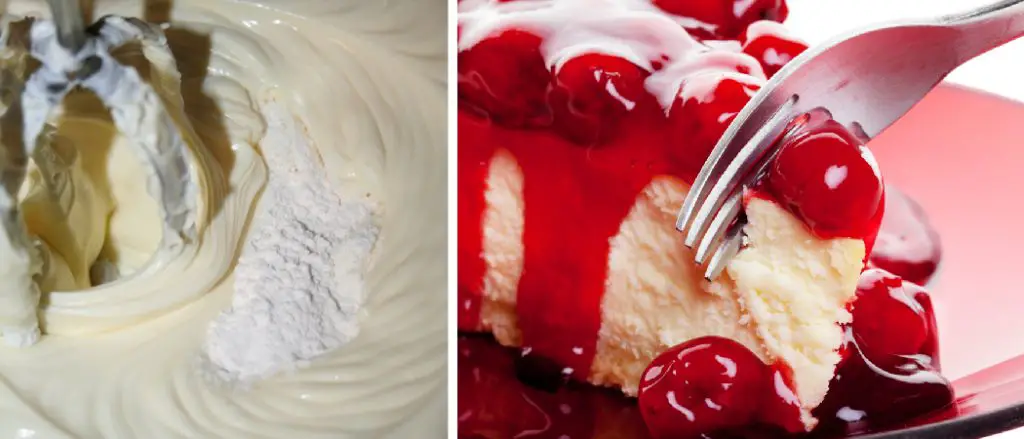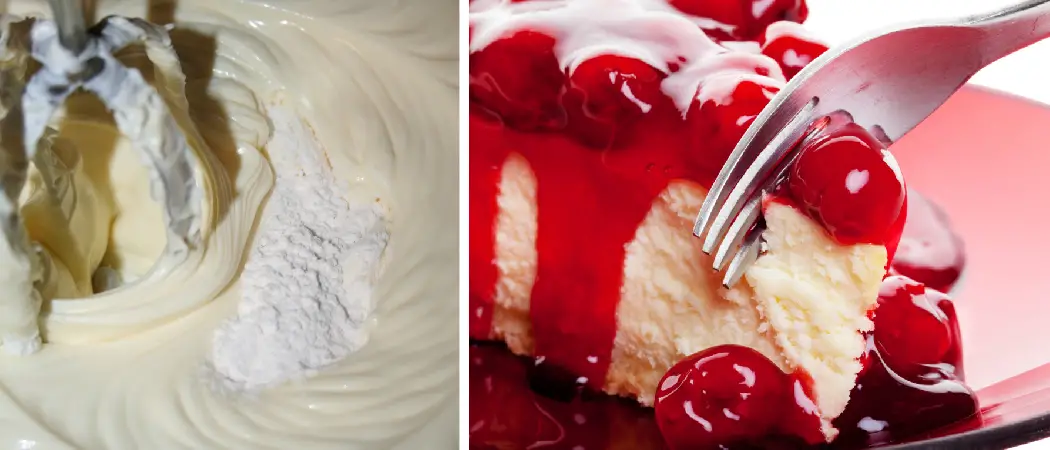To fix lumpy cheesecake batter, mix at low speed and scrape the sides of the bowl. Then, gently fold in any remaining lumps.
Lumpy cheesecake batter can be frustrating to deal with, but with a few simple techniques, you can easily achieve a smooth and creamy consistency. Whether you’re an experienced baker or just starting out, lumpy batter can happen to anyone. However, there’s no need to panic.
With the right approach, you can quickly fix the issue and continue making a delicious cheesecake. We will explore the common reasons for lumpy cheesecake batter and provide practical tips on how to remedy the situation. By following these steps, you’ll be on your way to creating a perfect, velvety smooth cheesecake every time.

Identifying The Problem
Lumpy cheesecake batter can be frustrating, especially when you’re looking forward to a smooth and creamy dessert. But fear not! By understanding the common causes of lumpy batter and recognizing the signs, you’ll be well on your way to fixing the issue and achieving that perfect, velvety texture.
What Causes Lumpy Cheesecake Batter?
Lumpy cheesecake batter can happen for a few different reasons. Let’s delve into some of the common culprits:
- Improper cream cheese temperature: When your cream cheese isn’t softened enough, and you mix it into the batter, lumps can form. Softening the cream cheese at room temperature allows it to blend smoothly.
- Overmixing the batter: While it’s important to thoroughly mix your ingredients, overmixing can cause excess air to be incorporated. This can result in a lumpy texture.
- Adding eggs too quickly: If you add your eggs all at once or too quickly, they may not combine properly with the other ingredients, leading to lumps.
- Using low-quality ingredients: Cheesecakes are all about the ingredients, so using subpar cream cheese or expired ingredients can lead to lumpy batter.
Signs Of A Lumpy Batter
Identifying a lumpy batter is crucial in fixing the issue. Here are a few signs to look out for:
- Small clumps or visible white specks in the mixture.
- An uneven texture with lumps that won’t blend in.
- A grainy appearance that differs from the smoothness you desire.
Recognizing these signs will help you determine whether your cheesecake batter needs some adjustments before baking.
Preventing Lumpy Cheesecake Batter
Use Room Temperature Ingredients
Before starting your cheesecake batter, ensure that all your ingredients, including cream cheese, eggs, and sour cream, are at room temperature. Cold ingredients can create lumps when mixed, resulting in a lumpy batter.
Mix Ingredients Thoroughly
When combining the ingredients, mix them thoroughly to ensure a smooth and lump-free batter. Use an electric mixer on a low speed to avoid incorporating too much air, which can cause cracks in the cheesecake.
Rescuing Lumpy Cheesecake Batter
Discover quick fixes to rescue your lumpy cheesecake batter before baking it to perfection!
Straining The Batter
Strain the lumpy batter through a fine-mesh sieve to smoothen the texture effortlessly.
Using An Immersion Blender
Blend the batter with an immersion blender until smooth, ensuring all lumps are eliminated.

Techniques For A Smooth Cheesecake
To ensure your cheesecake batter turns out smooth and creamy, it’s essential to follow the right techniques. Here are some tips to help you achieve a luscious, lump-free cheesecake:
Adding Ingredients In The Correct Order
- Start with room temperature ingredients.
- Add cream cheese first, followed by sugar, then eggs.
- Incorporate sour cream, flour, and flavorings last.
Avoiding Overmixing
- Mix on low speed only until ingredients are combined.
- Avoid overmixing to prevent air bubbles and lumps.
- Scrape the bowl occasionally to ensure even mixing.
Tips From The Experts
Learn how to fix lumpy cheesecake batter with expert tips for a smooth and creamy dessert.
Choosing The Right Cream Cheese
Use full-fat, room temperature cream cheese to avoid lumps in your batter.
- Opt for a high-quality brand like Philadelphia for best results.
- Avoid using low-fat or whipped cream cheese varieties.
Using A Water Bath
Prevent lumps by baking your cheesecake in a water bath for even heat distribution.
- Place your springform pan in a larger pan filled with hot water.
- This gentle and moist heat will prevent overcooking and lumps.

Common Mistakes To Avoid
When it comes to making a smooth and creamy cheesecake, it’s important to avoid common mistakes that can result in a lumpy batter. By understanding and avoiding these pitfalls, you’ll be well on your way to creating a perfect cheesecake every time. In this section, we’ll explore two key mistakes to avoid when making cheesecake: using cold ingredients and not properly creaming the cheese.
Using Cold Ingredients
One of the most common mistakes people make when making a cheesecake is using cold ingredients. This can lead to lumps in your batter and an uneven texture in your finished cheesecake. To ensure a smooth and creamy consistency, it’s crucial to use ingredients that are at room temperature.
When ingredients such as cream cheese, eggs, and sour cream are at room temperature, they blend together more easily, resulting in a luscious and uniform cheesecake batter. To bring your ingredients to room temperature, simply take them out of the refrigerator about 30 minutes before you plan to use them.
Not Properly Creaming The Cheese
The next common mistake to avoid is not properly creaming the cheese. Creaming the cheese refers to the process of beating the cream cheese until it becomes smooth and fluffy. This step is essential in ensuring a silky texture in your cheesecake.
To properly cream the cheese, start by beating the cream cheese on its own for a few minutes until it becomes soft and smooth. Add the sugar gradually and continue to beat until the mixture is light and fluffy. This process helps to incorporate air into the batter, resulting in a lighter and less dense cheesecake.
If you find that you still have lumps in your batter after creaming the cheese, try using a hand mixer or a stand mixer to further incorporate the ingredients. Be sure to scrape down the sides of the bowl periodically to ensure even mixing. Taking the time to properly cream the cheese will make a significant difference in the final texture of your cheesecake.
By avoiding these two common mistakes, you’ll be well on your way to a smooth and creamy cheesecake batter. Remember to use room temperature ingredients and take the time to properly cream the cheese. These simple tips will help you achieve a luscious and irresistible cheesecake that is sure to impress.
Troubleshooting Lumpy Batter
Fixing lumpy cheesecake batter is easy with a few simple tips. First, ensure all ingredients are at room temperature. And second, gently mix the batter to avoid overmixing, which can create lumps. Lastly, strain the batter to remove any remaining lumps for a smooth, creamy cheesecake.
Adjusting Oven Temperature And Bake Time
If your cheesecake batter is turning out lumpy, one possible culprit could be your oven temperature and bake time. It’s crucial to get these factors just right in order to achieve a smooth and creamy texture in your cheesecake.
Here are some tips on how to adjust your oven temperature and bake time:
- Make sure your oven is preheated to the correct temperature before you start baking your cheesecake. This ensures that the batter will cook evenly throughout.
- If your cheesecake is browning too quickly on the top but is still lumpy in the center, try reducing the oven temperature slightly and extending the bake time. This will allow the batter to fully cook without the top becoming too dark.
- On the other hand, if your cheesecake is getting too brown on the edges but is still lumpy in the center, you may need to reduce the overall bake time. This will prevent the cheesecake from overcooking on the edges while ensuring that the center is fully set.
By adjusting your oven temperature and bake time accordingly, you can achieve a smooth and luscious cheesecake batter without any lumps.
Checking For Undercooked Or Overcooked Cheesecake
If your cheesecake batter is lumpy, it could be a sign that the cheesecake is either undercooked or overcooked. Checking for the doneness of your cheesecake is crucial in troubleshooting and achieving a smooth batter.
Here are some indicators to help you determine if your cheesecake is undercooked or overcooked:
- A lumpy texture accompanied by a wet or jiggly center is a sign of undercooked cheesecake. In this case, you can continue baking the cheesecake for a little longer until the center is set.
- If your cheesecake has cracks on the surface, a dry and crumbly texture, and a darker color, it is most likely overcooked. To salvage an overcooked cheesecake, you can try adding a topping or sauce to mask the imperfections.
By carefully assessing the doneness of your cheesecake, you can troubleshoot and address the issues of lumpy batter caused by undercooking or overcooking.

Final Tips For Perfect Cheesecake
When it comes to achieving the perfect cheesecake, attention to detail is key. From properly cooling the cheesecake to ensuring it is chilled before serving, these final tips will ensure your cheesecake turns out smooth, creamy, and luscious. Here are the essential steps to follow for that flawless cheesecake every time.
Properly Cooling The Cheesecake
After the cheesecake is baked, it’s crucial to cool it properly. Allow the cheesecake to cool at room temperature for about an hour, then transfer it to the refrigerator. Let it chill for at least 4 hours or, ideally, overnight to ensure it sets perfectly. Avoid rushing this crucial step, as impatiently chilling a cheesecake can lead to a lumpy texture.
Chilling The Cheesecake Before Serving
Before serving, it’s crucial to chill the cheesecake for the best texture and flavor. Ensure the cheesecake is well-chilled in the refrigerator for a minimum of 4 hours before serving. Allow the flavors to meld and the texture to set by giving it ample time to chill. A well-chilled cheesecake will be easier to cut and have the perfect creamy consistency.
Frequently Asked Questions For How To Fix Lumpy Cheesecake Batter
How Do You Fix Curdled Cheesecake Batter?
To fix curdled cheesecake batter, start by removing it from the heat and letting it cool. Then, whisk in a tablespoon of warm milk to smooth out the mixture. If it’s still lumpy, use a hand mixer on low speed until it becomes creamy again.
How Do You Get Cream Cheese Lumps Out Of Batter?
To remove cream cheese lumps from batter, use these steps: 1. Soften the cream cheese beforehand. 2. Mix the cream cheese with a small amount of the batter until smooth. 3. Gradually add the remaining batter while constantly stirring. 4.
Use a blender or hand mixer if needed. 5. Continue mixing until the batter is free of lumps.
How Do You Make Cheesecake Batter Smooth?
To make cheesecake batter smooth, ensure all ingredients are at room temperature. Beat cream cheese and sugar until smooth. Add eggs one at a time, mixing well. Scrape sides of the bowl as needed. Use a high-quality mixer for a creamy texture.
Avoid overmixing to prevent air bubbles.
How Do You Get Rid Of Lumps In Cream Cheese?
To get rid of lumps in cream cheese, let it soften at room temperature and then use a hand mixer to beat it until smooth.
Conclusion
Fixing lumpy cheesecake batter is not as daunting as it seems. By following these simple tips, you can ensure that your batter is smooth and velvety, resulting in a perfect cheesecake. With a little patience and attention to detail, you’ll be able to create a decadent dessert that will impress your friends and family.

